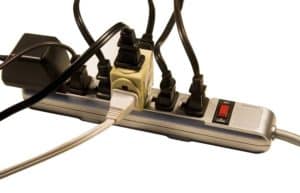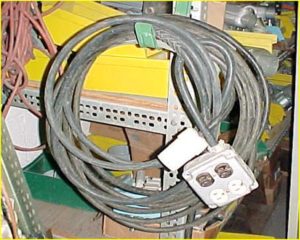OSHA Requirements for UL Rated Electrical Equipment
Power Strips; You’ll often find them in offices with printers, computers plugged into them, or in some cases even microwave ovens and refrigerators. In other cases, power strips are plugged into the end of an extension cord being used in shops and on construction sites to provide power to all sorts of tools or appliances. But is that safe, or unsafe? And, is it allowed by OSHA?

To answer that, you must first consider the following OSHA standard found at 1910.303(b)(2) in the OSHA general industry standards for electrical safety;
“Listed or labeled equipment shall be installed and used in accordance with any instructions included in the listing or labeling.”
There is a twin requirement to this standard that appears in 1926.403(b)(2) of the OSHA electrical safety standards for construction as well. This particular standard sounds very vague when you first read it, to the point it is very easy to ignore the deeper meaning. But beware – this particular OSHA standard can be violated in so many different ways. How? To understand how, you must understand what OSHA means when they say “listed or labeled equipment”.
Requirements for Independent Testing by Underwriter’s Laboratories (UL)
Manufacturers of electrical equipment to be used in the United States (and other countries) must have their product evaluated and/or tested by an independent evaluating agent to demonstrate it complies with appropriate requirements regarding reasonably foreseeable risks associated with the product. That product is then listed and labeled by the independent evaluating agent for a specific use or purpose. The most commonly used independent company performing this evaluation service in the United States is Underwriters Laboratory (UL), but, they are not the only testing lab utilized. So, when you pick up any electrical tool, appliance, or component, it usually will be stamped or labeled with the UL certification mark (or the mark of another independent testing lab similar), and it will be listed in their documentation for a specific approved purpose (or purposes). But many times, people never bother to look up the listing which describes the specific purpose. As a result, we often use the tool or piece of equipment for purposes for which it was not listed or approved.
Another source of information that can be readily accessed is the UL White Book (http://ul.com/wp-content/uploads/2014/09/UL-White-Book.pdf?utm_source=multiple&utm_medium=vanity&utm_campaign=codeauthoritieswhitebook). There you can look up a specific type of electrical equipment or components and, if it has been evaluated by UL, you will find the approved purpose(s) and in many cases, specific prohibitions.
Now, with that background information in mind, let’s look up power strips the UL White book. Power strips are actually called “relocatable power taps” in the UL book, and are referenced by the UL product category code XBYS. Sometimes power strips are equipped with an internal breaker and called a surge protector. Listing information about power strips is found on page 569 of the UP White Book at the link provided above.
There we can see that power strips are intended only for indoor use, and never for use on construction sites and similar locations. They are intended to be directly connected to a permanently installed branch-circuit receptacle outlet only, and not intended to be plugged into an extension cord or series connected (daisy chained) to other relocatable power taps. In addition, they are not intended to be permanently secured to building structures, tables, work benches or similar structures, nor are they intended to be used as a substitute for fixed wiring. Last but not least, they are only rated for 20 amps or less of power in total, meaning they are typically intended for use only with a few smaller appliances (such as a computers and printer), and not for connecting to higher amperage tools or appliances like microwave ovens and heaters (or refrigerators, or hammer drills, or grinders, or hoists . . .).
If this UL listing information is not evidence convincing enough to discourage misuse of power strips, OSHA has also issued a letter of interpretation regarding use (or misuse) of power strips at this link. https://www.osha.gov/pls/oshaweb/owadisp.show_document?p_table=INTERPRETATIONS&p_id=24631
Metal Receptacle Outlet Boxes Attached to Extension Cords
Standard Metallic Outlet Boxes are another commonly misused piece of electrical equipment. Information about standard metallic outlet receptacle boxes can be found under UL product category code QCIT, which appears on page 402 of the UL White Book. There we see that these metal boxes are usually mounted indoors, inside of, or onto the face of the walls of a structure. They usually contain one or two dual electrical outlets for plugging things in to them, and have “knockouts” so they can be connected to metal conduits to enclose the conductor wires. The boxes are also designed to be provided with an approved cover plate.
However, I often find these standard metallic outlet boxes attached to the end of a shop-fabricated extension cord running across the floor in manufacturing shops (and even in some office and warehouse environments). Or, they will be found laying on the ground at construction sites. And therein lies the problem.

According to the listing information in the UL White Book, it is stated that standard metallic outlet boxes must be installed in accordance with Article 314 of ANSI/NFPA 70, which is The National Electrical Code (NEC). And that code talks about how standard outlet boxes are intended to be mounted on solid structures and similar surfaces (like walls and electrical chase-ways), or as part of an approved pendant system. But nowhere does the code discuss installing a standard metallic outlet box so it dangles from the end of a portable extension cord being used as a temporary power supply.
These are not the only two situations where I see violations of the OSHA electrical standard requiring listed or labeled electrical equipment be installed and used only in accordance with any instructions included in the listing or labeling. But they are the most common examples I run across.
Have you seen these same misuses of power strips and metallic outlet boxes in the workplace? Can you think of misuses of other electrical equipment and components that would be violations of this OSHA standard? If you do, please scroll down to share your thoughts with us about this topic in the “Comments” section of this post. And last but not least, I would like to encourage you to Share this Blog post with others in your Network who might benefit from reading this information. Thanks – Curtis


6 thoughts on “Misuse of Power Strips, Surge Protectors, and Receptacle Boxes”
Hi Curtis,
Thanks for your article. There is still one thing I’m not sure about… Does the US Government require power strip manufacturers to have their products certified by an NRTL (like UL for example)? If so, is there any penalty if the power strip is not certified? I have seen some out there, especially on Amazon, that are not certified.
Hello Bob. Let me start by saying I am not an attorney, so this is not legal advice, just my understanding of the OSHA rules. And the answers I am providing are based on the FAQ’s about this topic that are available on OSHA’s website (see https://www.osha.gov/nationally-recognized-testing-laboratory-program/frequently-asked-questions). The short answer is that I am not aware of any blanket US law that requires ALL electrical equipment in the US be tested by a NRTL. But, OSHA does require power strips USED IN THE WORKPLACE be certified by a Nationally Recognized Testing Lab (NRTL) such as UL. The standard that applies here is 1910.303(a), which states “The conductors and equipment required or permitted by this subpart shall be acceptable only if approved, as defined in Sec. 1910.399.” And 1910.399 states an installation or equipment is acceptable to OSHA, and approved within the meaning of this subpart S, if:
(1) If it is accepted, or certified, or listed, or labeled, or otherwise determined to be safe by a nationally recognized testing laboratory recognized pursuant to § 1910.7; or
(2) With respect to an installation or equipment of a kind that no nationally recognized testing laboratory accepts, certifies, lists, labels, or determines to be safe, if it is inspected or tested by another Federal agency, or by a State, municipal, or other local authority responsible for enforcing occupational safety provisions of the National Electrical Code, and found in compliance with the provisions of the National Electrical Code as applied in this subpart; or
(3) With respect to custom-made equipment or related installations that are designed, fabricated for, and intended for use by a particular customer, if it is determined to be safe for its intended use by its manufacturer on the basis of test data which the employer keeps and makes available for inspection to the Assistant Secretary and his authorized representatives.
Keep in mind that OSHA only regulates employers, so they lack the jurisdiction to “require manufacturers or suppliers, as applicable, to have the products they manufacture or supply certified by an NRTL. That said, it would be in the interest of manufacturers or suppliers, as applicable, to have products requiring approval under OSHA standards to be NRTL-certified, as many, if not all, of their customers are most likely employers that must follow applicable OSHA standards requiring approval of products and equipment.” And it is also possible that some other agency (e.g.: federal, state, municipality . . .) has a specific approval requirement for equipment used under their jurisdiction.
As for any penalties for non-approved equipment; OSHA can cite the above standards for sub-standard equipment found in use (or available for use) in the workplace. And those citations can carry monetary penalties that, depending on various factors, be as high as $16,550 per violation as of January 15, 2025.
Hope this helps. Curtis
Hey Curtis,
Great article. I understand it is more about UL ratings and how OSHA uses them but I have a question regarding a 2 gang wall mounted outlet in a shop environment. I installed a direct plug in adaptor that converts the outlet to 6 plugs that we use to charge laptops. Is that considered permanently secured and would the “power strip” bend or break OSHA regulations? My insurance rep brought it up but wasn’t sure either.
Thanks
Hello Dale. I can’t envision exactly what device you are asking about. I suggest you just look up the device on the manufacturer’s website and see what it is rated / intended for, then compare that to your current use and environment. Sorry I couldn’t be more help.
Hey Curtis. Quick question… Is it safe to plug a 4 way metallic box into another 4 way metallic box? (not permanently wired). This gives me a total of 8 outlets to use on one
Hello Brett. No, not safe, or at least not compliant. Metal 4-way boxes, at least those intended for permanent installation, are not intended for use on the end of a cord, which is how I envision what you are describing in your question. Hope this helps.